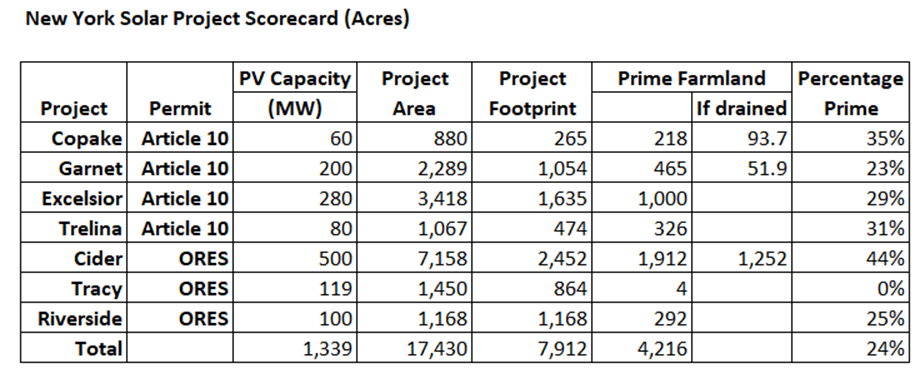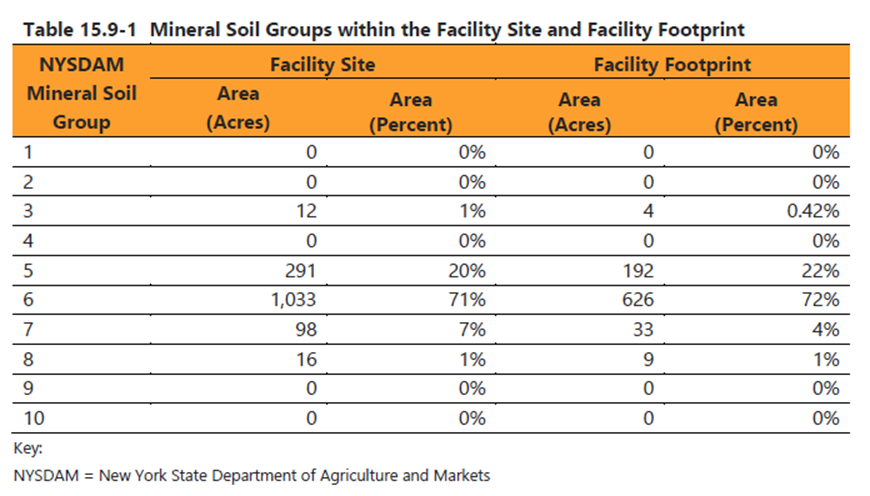I have been writing about the Climate Leadership & Community Protection Act (Climate Act) for over four years and one of my primary concerns is the effect of solar developments on New York agriculture. Kris Martin sent me the Enough Land: How will solar development affect upstate New York agriculture? white paper (“White Paper”) on agricultural land use and solar buildout in Upstate NY that she just completed. It is a well-researched analysis that looks at how much solar capacity we need to meet Climate Act goals and how much farmland that will require.. Kris has kindly offered to let me provide it to my readers.
I have followed the Climate Act since it was first proposed, submitted comments on the Climate Act implementation plan, and have written over 350 articles about New York’s net-zero transition. I have frequently written about issues related to solar development and Upstate agriculture. I have devoted a lot of time to the Climate Act because I believe the ambitions for a zero-emissions economy embodied in the Climate Act outstrip available renewable technology such that the net-zero transition will do more harm than good by increasing costs unacceptably, threatening electric system reliability, causing significant unintended environmental impacts, and adversely affecting the way of life in rural New York. The opinions expressed in this post do not reflect the position of any of my previous employers or any other organization I have been associated with, these comments are mine alone.
Climate Act Background
The Climate Act established a New York “Net Zero” target (85% reduction and 15% offset of emissions) by 2050. It includes an interim 2030 reduction target of a 40% reduction by 2030 and a requirement that all electricity generated be “zero-emissions” by 2040. The Climate Action Council is responsible for preparing the Scoping Plan that outlines how to “achieve the State’s bold clean energy and climate agenda.” In brief, that plan is to electrify everything possible using zero-emissions electricity. The Integration Analysis prepared by the New York State Energy Research and Development Authority (NYSERDA) and its consultants quantifies the impact of the electrification strategies. That material was used to develop the Draft Scoping Plan. After a year-long review, the Scoping Plan recommendations were finalized at the end of 2022. In 2023 the Scoping Plan recommendations are supposed to be implemented through regulation and legislation.
Kris Martin
Kris sent me the following biographical information:
I grew up in a western NY farming community with three colleges; I’ve had a lifelong interest in agriculture and technology. I earned a BA from SUNY Empire State College and an MS in technical communication from Rensselaer Polytechnic Institute. After graduating, I worked as a software engineer and technical writer at IBM Research receiving national and international awards for my writing. Upon retiring, I moved back to western NY.
The preface describes the impetus for the white paper. She had heard the argument that the solar buildout for New York would only require 1% of the state’s farmland. She did a quick analysis and realized that a more realistic estimate was needed. She explains:
Maybe I could come up with more realistic estimates. Supporters of large-scale solar and those who opposed it needed some real numbers. I could produce them in a couple of weekends. That was over three years ago.
I can certainly sympathize with that time estimate. In my experience, nothing associated with any component of the Climate Act is as simple as it first appears. As a result, any analysis and documentation takes much longer than I originally thought. That is especially true if you want to document exactly what you found so that the analysis is credible. The description of the document includes this disclaimer: “This document is neither a statistical analysis nor an academic work; it should not be used as a formal reference.” It may not be a peer-reviewed work but it is referenced well, the calculations documented, and the conclusions are supported by the work. It is citizen-science at its finest and I would have no qualms quoting it in my work.
Enough Land
Martin describes the document:
Many upstate New York residents object to solar development on farmland, arguing that we should prioritize food production over energy generation. Others dismiss these concerns as unnecessary. This paper uses government and industry data—along with stated assumptions—to estimate how much agricultural land New York State’s expected level of solar buildout will require. The assessment also places solar land use in the larger context of the state’s farmland losses.
The chapters that follow address these overall questions:
- Why do we need to site solar facilities on farmland?
- How much solar capacity will the state need by 2050?
- How much farmland will this require?
- How much agricultural land do we have?
- What effects does solar buildout have on agriculture?
Appendices provide more information on related topics.
She explains that the questions addressed in the white paper are simple: how much solar energy do we need, and how much farmland will it re-quire and what do these amounts mean for upstate agriculture?
Results
Cutting to the chase, Martin compares the acreage of New York State farmland as of 2017 and the acreage required by 2040 and 2050 for solar development in the following table. She explains:
The claim that solar development will require only 1% of New York State’s land is roughly correct. On the other hand, solar buildout will require more than 1% of the state’s farmland.
Note that these numbers reflect acreage on the facility site; they do not include land used for mitigation or land taken out of production around facilities because it is less accessible or abandoned for other reasons.

I like the White Paper because it provides context for everything covered. Estimating the amount of land is dependent upon area per solar panel installation and how much capacity is required for the Climate Act. Those topics are covered in sufficient detail that it is clear why the numbers used were chosen. This extends to the results. There is a chapter that “considers the loss of farmland that has been occurring over the last century and speculates on the reasons for farmland conversion over that period.” The White Paper provides a projection of expected additional farmland and cropland losses by 2050 not related to solar development. While there are inconsistencies in the data used such that there is “missing” land, the results are troubling.

The section “How Much Land” assesses cumulative farmland losses from both solar and non-solar causes and puts the estimates in context. Martin addresses the question whether this is a little or a lot but finds that more context is needed. She explains: “Let us consider some of the factors relating to our current and future land use, and their relationship to solar development.”
- The explanation takes up an entire chapter. The chapter looks at the following issues:
- Climate change and agriculture
- Farmland values in New York and other states
- Farming and farmers
- Concentrations of solar development, with examples
- Agrivoltaic solutions
I really liked this chapter because it frames the issues very well. My goal as a pragmatic environmentalist is to try to provide the information that I think should be considered when decisions are made. Invariably there are tradeoffs and the decisions made will reflect value judgements. This chapter provides the information and avoids making conclusions about which tradeoffs are appropriate.
One aspect of solar development that I had not considered previously is the effect of co-locating solar developments in the same area. When several grid-scale solar projects are concentrated in one agricultural area there are adverse impacts to the remaining farmers. I have long contended that the State has failed to provide a cumulative environmental impact assessment for the currently projected amount of solar and wind development. The Final Supplemental Generic Environmental Impact Statement (SGEIS) for the Climate Leadership and Community Protection Act was released on September 17, 2020 and only included 13,200 MW of utility-scale solar. This analysis assumes that utility-scale solar will be on the order of 45,000 MW or over three times what the State analyzed.
Discussion
After three years of extensive work Kris Martin has assembled a great resource on solar development and its potential impacts on New York agriculture. She confronts the tradeoffs:
Ultimately, we may be facing a conflict between the rights of landowners to use farmland for any legal purpose and our collective need for farmland as a vital resource. Because most of us do respect the long hours, hard work, and inherent risks that farmers take, we naturally sympathize with their decisions to take farmland out of production or change the focus of their operations by leasing or selling land for solar development.
Farming is not an altogether benevolent activity. It can reduce biological diversity, introduce harmful chemicals into the environment, and consume massive subsidies that fail to improve life for many farmers or increase the production of affordable, healthy food and other agricultural products.
Do we have enough farmland for solar buildout on the scale required to meet Climate Act goals? Keep in mind that the Climate Act is a law, not simple policy. Its success depends on our having more farmland than we need in order to produce food, fiber, and fuel.
The answer to this question may be somewhat subjective. We may not even know the answers until it is too late to do much about the issue.
She includes recommendations for state policymakers, solar developers, community leaders, other individuals, and host farmers.
Conclusion
My takeaway from the White Paper is that it provides the context that the Hochul Administration should have provided for solar development. The fact is that there still is no utility-scale solar development plan for the Climate Act. There is no mandate to follow the Department of Agriculture & Markets targets for conversion of agricultural lands or explanation why meeting the targets should not be mandated. The Scoping Plan estimates for solar capacity availability assume that tracking solar panels are used but the that is not mandated so fixed panel systems are being installed. That means even more land will be taken up by industrial solar development. Finally, there is no mandate for agrivoltaics. This White Paper shows what should have been done.
I agree with Martin’s conclusion:
We cannot afford to make bad decisions about farmland or energy production. Today’s priorities may become tomorrow’s regrets. The conflicts identified here will require all our efforts, open-mindedness, and thoughtful engagement to negotiate.







